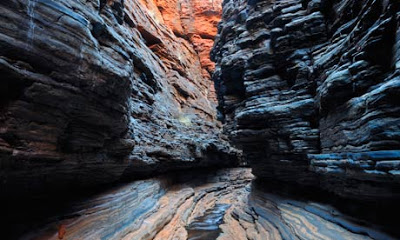
Scientists analysing Australian rocks have discovered traces of bacteria that lived a record-breaking 3.49bn years ago, a mere 1bn years after Earth formed.
If the find withstands the scrutiny that inevitably faces claims of fossils this old, it could move scientists one step closer to understanding the first chapters of life on Earth. The discovery could also spur the search for ancient life on other planets.
These traces of bacteria “are the oldest fossils ever described. Those are our oldest ancestors,” said Nora Noffke, a biogeochemist at Old Dominion University in Norfolk, Virginia, who was part of the group that made the find and presented it in November at a meeting of the Geological Society of America. Unlike dinosaur bones, the newly identified fossils are not petrified body parts. They’re textures on the surfaces of sandstone thought to be sculpted by once-living organisms.
Today, similar patterns decorate parts of Tunisia’s coast, created by thick mats of bacteria that trap and glue together sand particles. Sand that is stuck to the land beneath the mats and thus protected from erosion can over time turn into rock that can long outlast the living organisms above it.
Finding the earliest remnants of this process required a long, hard look at some of the planet’s oldest rocks, located in Western Australia’s Pilbara region. This ancient landscape was once shoreline. Rocks made from sediment piled up billions of years ago are now exposed and available for examination. Relatively pristine in condition, such outcrops, along with others in South Africa, have long been a popular place to look for traces of life from the Archean eon, which ended 2.5bn years ago.
There are older rocks on Earth, said Maud Walsh, a biogeologist at Louisiana State University in Baton Rouge. “But these are the best-preserved sedimentary rocks we know of, the ones most likely to preserve the really tiny structures and chemicals that provide evidence for life.”
Last year, another team of researchers published the discovery of microscopic fossils in Pilbara’s Strelley Pool Formation, about 3.4bn years old. “It’s not just finding this stuff that’s interesting,” says Alan Decho, a geobiologist at the University of South Carolina’s Arnold School of Public Health. “It’s showing that the life had some organisation to it.” Ridges that crisscross the rocks like strands in a spider web hint that primitive bacteria linked up in sprawling networks. Like their modern counterparts, they may have lived in the equivalent of microbial cities that hosted thousands of kinds of bacteria, each specialised for a different task and communicating with the others via chemical signals.
Many of the textures seen in the Australian rocks had already shown up in 2.9bn-year-old rocks from South Africa, reported on by Noffke and colleagues in 2007.
Still, old Australian rocks have proved deceptive before. As early as 1980, rippling layers within the Strelley Pool were thought to be the handiwork of bacteria. But such stromatolites, which are different from the structures that Noffke studies, can also be the work of natural, non-living processes. For instance, water flowing along a seafloor can create similar structures under the right conditions. So can spraying jets of liquid loaded with particles onto a surface, as scientists at Oxford University demonstrated in laboratory experiments.
That’s why Noffke and her colleagues corroborated their story by measuring the carbon that makes up the textured rocks. About 99% of carbon in non-living stuff is carbon-12, a lighter version of the element than the carbon-13 that accounts for most of the remaining 1%. Microbes that use photosynthesis to make their food contain even more carbon-12 and less carbon-13. That bias, a signature of “organic” carbon that comes from a living being, showed up in the Australian rock.
“It’s always nice to have a number of different lines of evidence, and you definitely want to see organic carbon,” says geomicrobiologist John Stolz of Duquesne University in Pittsburgh.
What wasn’t preserved: any proteins or fats or body fossils that would clinch the case for life and identify what types of bacteria left behind this organic carbon. Most microbial mats today contain lots of photosynthetic cyanobacteria, which make the food that sustains the other bacteria. Named after the blue-green pigment they use for this process, called phycocyanin, cyanobacteria also make oxygen and are given the credit for creating Earth’s atmosphere about 2.4bn years ago.
Cyanobacteria living in microbial mats nearly 3.5bn years ago could shake up the history of the air we all breathe.
“Studying this kind of past life is really about learning how the Earth got to be the way it is today,” says Michael Tice, a geobiologist at Texas A&M University.
Ultimately, the fossils found on Earth could help those looking for the building blocks of life on Mars, where Nasa’s Curiosity rover has recently found evidence for ancient waterways. Remnants of life on the red planet might even be better preserved than they are here on Earth, says Harvard University paleontologist Andrew Knoll. That’s because old terrestrial rocks tend to get banged around by the movement of tectonic plates and cooked by the extreme heat of the planet’s depths. Mars, a planet that’s nearly dead geologically, lacks such tectonic activity.
Though no signs of ancient Martian microbes have been found, fossil hunters may now have something new to start looking for.
• This article was amended on 9 January 2013 to delete a reference to the archaeologically productive Pilbara region: the age of the fossils found would better suit the field of palaeontology. A missing fragment of a quote from geobiologist Alan Decho has also been reinstated.
Note : The above story is reprinted from materials provided by guardian.co.uk. The original article was written by Devin Powell for the Washington Post










